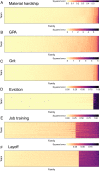Measuring the predictability of life outcomes with a scientific mass collaboration
- PMID: 32229555
- PMCID: PMC7165437
- DOI: 10.1073/pnas.1915006117
Measuring the predictability of life outcomes with a scientific mass collaboration
Erratum in
-
Correction for Salganik et al., Measuring the predictability of life outcomes with a scientific mass collaboration.Proc Natl Acad Sci U S A. 2021 Dec 14;118(50):e2118703118. doi: 10.1073/pnas.2118703118. Proc Natl Acad Sci U S A. 2021. PMID: 34857664 Free PMC article. No abstract available.
Abstract
How predictable are life trajectories? We investigated this question with a scientific mass collaboration using the common task method; 160 teams built predictive models for six life outcomes using data from the Fragile Families and Child Wellbeing Study, a high-quality birth cohort study. Despite using a rich dataset and applying machine-learning methods optimized for prediction, the best predictions were not very accurate and were only slightly better than those from a simple benchmark model. Within each outcome, prediction error was strongly associated with the family being predicted and weakly associated with the technique used to generate the prediction. Overall, these results suggest practical limits to the predictability of life outcomes in some settings and illustrate the value of mass collaborations in the social sciences.
Keywords: life course; machine learning; mass collaboration; prediction.
Copyright © 2020 the Author(s). Published by PNAS.
Conflict of interest statement
Competing interest statement: B.E.E. is on the scientific advisory boards of Celsius Therapeutics and Freenome, is currently employed by Genomics plc and Freenome, and is on a year leave-of-absence from Princeton University.
Figures




Comment in
-
What failure to predict life outcomes can teach us.Proc Natl Acad Sci U S A. 2020 Apr 14;117(15):8234-8235. doi: 10.1073/pnas.2003390117. Epub 2020 Apr 1. Proc Natl Acad Sci U S A. 2020. PMID: 32238558 Free PMC article. No abstract available.
References
-
- Athey S., Beyond prediction: Using big data for policy problems. Science 355, 483–485 (2017). - PubMed
-
- Blau P. M., Duncan O. D., The American Occupational Structure (John Wiley and Sons, 1967).
-
- Chetty R., Hendren N., Kline P., Saez E., Where is the land of opportunity? The geography of intergenerational mobility in the United States. Q. J. Econ. 129, 1553–1623 (2014).
-
- Feuerverger A., He Y., Khatri S., Statistical significance of the Netflix challenge. Stat. Sci., 202–231 (2012).
Publication types
MeSH terms
Grants and funding
- R25 HD074544/HD/NICHD NIH HHS/United States
- R01 HD039135/HD/NICHD NIH HHS/United States
- P2C HD042828/HD/NICHD NIH HHS/United States
- R24 HD047879/HD/NICHD NIH HHS/United States
- T32 HD007545/HD/NICHD NIH HHS/United States
- P2C HD047879/HD/NICHD NIH HHS/United States
- R01 HD036916/HD/NICHD NIH HHS/United States
- R01 HL133218/HL/NHLBI NIH HHS/United States
- MC_PC_17209/MRC_/Medical Research Council/United Kingdom
- R01 HD040421/HD/NICHD NIH HHS/United States
- P2C HD041022/HD/NICHD NIH HHS/United States
- R25 HD072818/HD/NICHD NIH HHS/United States
LinkOut - more resources
Full Text Sources

